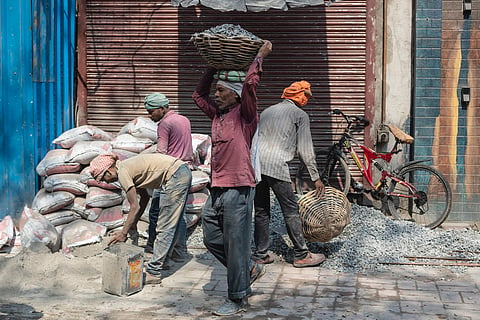

More than 80 per cent of the world’s population in multidimensional poverty lives in regions exposed to climate hazards, says the “2025 Global Multidimensional Poverty Index” released by the United Nations Development Programme (UNDP) and the Oxford Poverty and Human Initiative (OPHI) at the University of Oxford.
For the first time, the Index has mapped the multidimensionally poor population’s exposure to four climate hazards — high heat, drought, floods and air pollution.
The UNDP-OPHI report says that of the 1.1 billion multidimensionally poor people, 887 million live in regions with at least one of the above four climate hazards. Of this population, the majority — 608 million — are exposed to high heat areas. Some 577 million are exposed to air pollution, 465 million to floods and 207 million to drought.
“Many poor people face overlapping climate hazards: 651 million face two or more hazards and 309 million people three or four,” says the report. Middle-income countries have the highest percentage of multidimensionally poor populations exposed to any climate hazard at 72.2 per cent.
“Upper-middle-income countries have fewer poor people in absolute terms. But their exposure to climate hazards is disproportionately high—91.1 per cent of poor people (93 million) in these countries face at least one climate hazard,” says the report.
The South Asia region has the highest number of multidimensionally poor living in areas affected by climate hazards. Some 380 million poor in South Asia have significant climate hazard exposures, while the sub-Saharan Africa region has 344 million poor exposed to such hazards.
“While South Asia has driven global progress in reducing multidimensional poverty since 2005-2006, the region is the most exposed to overlapping climate hazards. Almost all poor people in South Asia (99.1 percent) live in regions affected by at least one climate hazard, while 59 percent (226 million) are exposed to three or four climate hazards,” says the report.
Multidimensionally poverty level has been dipping over the last two decades. “In 2005–2006, 55.1 percent of people in India were poor. The share plummeted to 16.4 percent in 2019-2021; roughly 414 million people left poverty,” says the report.
Both the regions have been the global hotspots for poverty and exposure to climate hazards. “High levels of multidimensional poverty often coincide with intense heat, drought, air pollution and/or flooding. Large swathes of Bangladesh, India and Pakistan face an acute mixture of poverty, high heat, flooding and widespread air pollution,” says the report.
It is a conundrum in face of the century’s existential threat: Climate change. Warming of the planet has resulted in a climate that is erratic and devastating, particularly for the world’s poor whose greenhouse gas emissions are minuscule. The poor are the direct victims of climate change. Further, this risk and vulnerability results in them losing the capacity to move out of poverty.
“Poor people disproportionately experience climate hazards, a reality that threatens to derail efforts to eliminate poverty. Impoverished households are especially exposed to climate shocks as many depend on high-risk sectors such as agriculture and informal labour,” says the report.
“The burdens identified are not limited to the present but are expected to intensify in the future,” says Pedro Conceição, Director of the Human Development Report Office, UNDP. “Analysis of temperature projection data reveals that countries with higher current levels of multidimensional poverty are predicted to experience the greatest increases in temperatures by the end of this century,” the report indicates.
“Poverty, once seen as mainly a standalone socioeconomic concern, is now inextricably linked with planetary pressures. Without ambitious efforts to mitigate climate fallout, the number of people in extreme monetary poverty could nearly double by 2050,” warns the report.